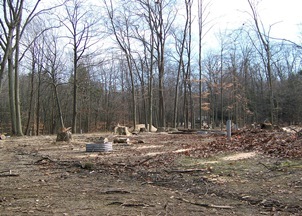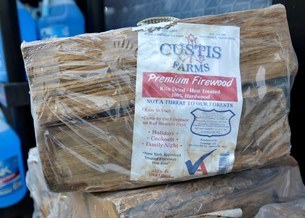|
Oct. 5, 2017
Contact: Sue Tangora, 517-284-5886 or Joanne Foreman, 517-284-5814
If you love fall fun, leave firewood at home
Buy locally at your destination to prevent the spread of invasive species
As you prepare to hit the road for your favorite fall recreation activities, the Michigan departments of Natural Resources and Agriculture and Rural Development remind you to play it safe by leaving firewood at home.
October is Firewood Awareness Month, and the departments are joining with The Nature Conservancy and the U.S. Department of Agriculture’s Animal and Plant Health Inspection Service to encourage everyone to buy firewood near where they will burn it to prevent starting a new infestation of an invasive insect or disease.
“Michigan’s forests and urban landscapes have already been decimated by Dutch elm disease, emerald ash borer and gypsy moth. Now we are battling oak wilt and beech bark disease,” said John Bedford, pest response program specialist with the Michigan Department of Agriculture and Rural Development. “Thousand cankers disease of walnut and the Asian longhorned beetle, which attacks maples and several other hardwood species, are both as nearby as Ohio. These tree killers could be just one bundle of firewood away.”
 Joanne Foreman, DNR invasive species communications coordinator, said that some of the best fall activities in Michigan rely on the health of forests. Joanne Foreman, DNR invasive species communications coordinator, said that some of the best fall activities in Michigan rely on the health of forests.
“If you enjoy the fall colors up north or like to hunt, fish or hike, imagine what your destination would be like with one less tree species,” she said.
“On their own, these insects and diseases can’t travel very far, but they can travel hundreds of miles on firewood,” said Sue Tangora, DNR forest health and cooperative programs section supervisor. “Trees cut for firewood often died due to insects or disease. Why risk carrying oak wilt to your cabin or beech bark disease to your favorite camping spot?”
If you buy firewood and don’t burn it all, don’t take it home with you or to your next destination.
Wood that looks clean and healthy can still have tiny insect eggs or microscopic fungi spores that will start a new and deadly infestation.
Many state parks already affected
According to Heidi Frei, a DNR natural resources steward, many state parks throughout Michigan already are showing the effects of unchecked invasive species.
“Otsego Lake, South Higgins Lake, Interlochen, Warren Dunes, Hartwick Pines, Waterloo, Brighton and Island Lake are just a few of the Michigan state parks and recreation areas that have been hit hard by invasive forest pests,” Frei said.
“For example, over the last six years, more than 500 trees in P.J. Hoffmaster State Park have been lost to oak wilt,” she said. “The campground, which once was home to beautiful, mature red oaks, had to be almost entirely clear-cut because of infestation. That resulted in the loss of campsites surrounded by the forest canopy, important wildlife habitat and much-needed shade.”
Frei said those are clear reminders about the importance of not moving firewood and of using only certified wood.
Certified is the best choice
 Certified firewood that has been heat-treated to USDA certification standards – 140 degrees Fahrenheit at the core for at least one hour – is safe to transport within and beyond Michigan’s borders. Certified wood will bear a USDA compliance stamp or a state-based (such as a State Department of Agriculture) heat treatment stamp and be clearly marked with the producer’s name and address. Certified firewood that has been heat-treated to USDA certification standards – 140 degrees Fahrenheit at the core for at least one hour – is safe to transport within and beyond Michigan’s borders. Certified wood will bear a USDA compliance stamp or a state-based (such as a State Department of Agriculture) heat treatment stamp and be clearly marked with the producer’s name and address.
Always leave your firewood at home, even if you think the firewood looks fine. If certified firewood is not available, purchase your firewood as close as possible to where you will be using it. Ask the seller where they got the wood. If it isn’t nearby, or if they don’t know where the wood is from, consider another firewood dealer.
Those worried about firewood availability at their destinations can visit www.firewoodscout.org to find nearby vendors. Since costs can vary, call ahead to find the best deal.
“Remember, you can still have a roaring campfire or a cozy night in front of the fireplace and continue to enjoy Michigan’s unique beauty for decades to come by making wise firewood decisions now," Foreman said.
For more information and FAQs on the risks associated with firewood movement, visit www.dontmovefirewood.org/how-to-help/f-a-q/.
Michigan firewood facts are available on the MDARD website, and more information about invasive pests and diseases threatening Michigan’s trees is available at www.michigan.gov/invasives.
/Note to editors: Accompanying photos are available below for download. Suggested caption information follows.
Certified_firewood_USACE.jpg: A certification stamp and the name and address of the firewood supplier should be visible on any certified firewood label. Photo courtesy USACE.
Firewood_split_pile.jpg: Aged or seasoned wood still can harbor bugs and spores that can affect living trees. Photo courtesy L. Greenwood, The Nature Conservancy.
Oak_wilt_Hoffmaster.jpg: Hundreds of trees have been removed from the campground at P.J. Hoffmaster State Park in Muskegon, due to an infestation of oak wilt./
The Michigan Department of Natural Resources is committed to the conservation, protection, management, use and enjoyment of the state’s natural and cultural resources for current and future generations. For more information, go to www.michigan.gov/dnr.
|

 Joanne Foreman, DNR invasive species communications coordinator, said that some of the best fall activities in Michigan rely on the health of forests.
Joanne Foreman, DNR invasive species communications coordinator, said that some of the best fall activities in Michigan rely on the health of forests. Certified firewood that has been heat-treated to USDA certification standards – 140 degrees Fahrenheit at the core for at least one hour – is safe to transport within and beyond Michigan’s borders. Certified wood will bear a USDA compliance stamp or a state-based (such as a State Department of Agriculture) heat treatment stamp and be clearly marked with the producer’s name and address.
Certified firewood that has been heat-treated to USDA certification standards – 140 degrees Fahrenheit at the core for at least one hour – is safe to transport within and beyond Michigan’s borders. Certified wood will bear a USDA compliance stamp or a state-based (such as a State Department of Agriculture) heat treatment stamp and be clearly marked with the producer’s name and address.




